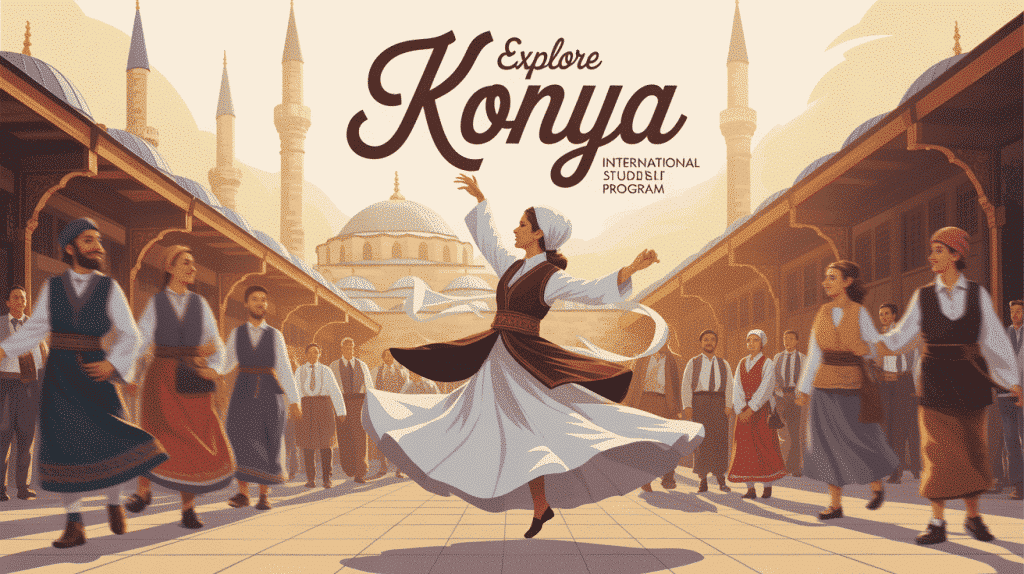Local Traditions and Customs in Konya: A Guide for International Students
The Spiritual Heart of Konya: Whirling Dervishes and the Mevlevi Order
Konya is globally recognized as a spiritual center of Sufism, largely due to its historical ties to the illustrious poet and mystic Jalal al-Din Rumi. Known for founding the Mevlevi order in the Ottoman era, the city is a focal point for spiritual seekers and cultural enthusiasts alike. One of its most prominent traditions is the sema ceremony, performed by the whirling dervishes.
What is the Sema Ceremony?
The sema is not merely a dance; it is a spiritual journey symbolizing the quest for divine unity. Dervishes clad in flowing white robes engage in a mesmerizing spinning dance, captivating audiences with their grace. Regular demonstrations occur at the Konya Cultural Centre, with the most significant celebrations during the annual Mevlâna Festival held every December.
Key Takeaway: Attending a sema performance is a profound experience for students, offering them a glimpse into the spiritual and cultural values that shape the identity of Konya.
Annual Celebrations: The Significance of the Mevlâna Festival
Every December, Konya transforms as it hosts the Mevlâna Festival, a ten-day celebration honoring Rumi’s legacy. This festival attracts over a million visitors and features a series of events, including:
- Sema ceremonies
- Spiritual gatherings
- Cultural exhibitions
The crescendo of the festival is the Seb-i Arus, a ritual symbolizing Rumi’s “wedding night” with the Divine, attended by dignitaries and Sufi followers from around the globe.
Impact on International Students
The Mevlâna Festival provides students an opportunity not only to witness vibrant cultural expressions but to engage in discussions with individuals from varied backgrounds. It fosters a true sense of global community and encourages cultural exchange.
Understanding Local Etiquette: Traditional Attire and Social Norms
In Konya, modest clothing reflects the city’s conservative values. Both locals and visitors are encouraged to wear long trousers and shirts that cover the shoulders. Understanding these social nuances is essential for international students, as it not only shows respect for local customs but also enhances the overall experience.
Social Life and Religious Practices
The structure of daily life in Konya, particularly during religious periods like Ramadan, revolves around prayer, family gatherings, and communal celebrations. Engaging with the local customs creates a deeper connection with the community and reinforces the cultural experience.
The Joy of Music: The Barana Tradition
Music plays a vital role in the social fabric of Konya, particularly through the barana tradition. Unique to the region, barana gatherings often involve young adults coming together for musical performances that foster social solidarity and community bonding.
A Form of Cultural Expression
These gatherings serve two purposes:
- They are artistic performances.
- They offer a collaborative space for social interaction.
For international students, participating in a barana provides a unique opportunity to learn about local music, forge friendships, and immerse themselves in the community’s cultural richness.
Culinary Delights: Exploring Konya’s Gastronomy
Konya is celebrated not just for its history and spirituality but also for its diverse culinary offerings. The local cuisine boasts traditional recipes, making it a gastronomic haven.
Must-Try Dishes
- Etli ekmek: A flatbread topped with ground beef, tomatoes, and peppers.
- Fırın kebap: Slow-roasted mutton, known for its tenderness.
Sweet Specialties
- Höşmerim: A creamy dessert made with milk, cheese, semolina, and nuts.
- Mevlana candies: Famous crystalline sweets that are a popular souvenir.
Culinary Experiences
For students, exploring local markets and participating in cooking classes can provide deeper insights into the culture while facilitating connections with residents.
Artistic Expression: Handicrafts and Local Craftsmanship
Konya’s artistic traditions are reflected in its handicrafts, including point lace and embroidered rugs. These local artifacts, showcased in various museums, illustrate the city’s rich heritage and the artistic legacy of the Seljuk and Ottoman eras.
Connecting with Local Artisans
Students are encouraged to engage with local artisans, as this interaction can lead to a better understanding of the cultural narratives that these crafts embody.
Take the Next Step with Study in Turkiye
Are you ready to explore and embrace the remarkable cultural landscape of Konya? Let us help you on your journey.

